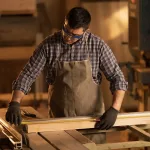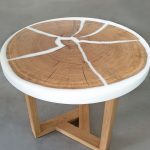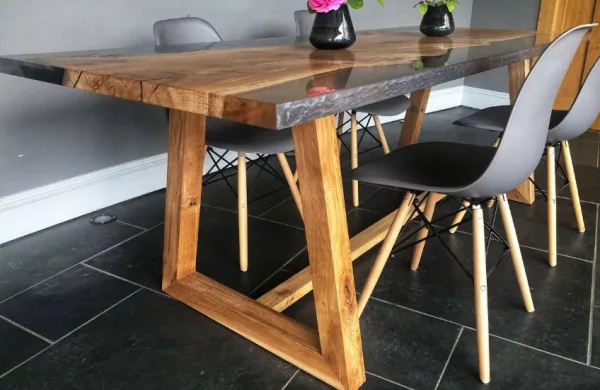Selecting the right material for your kitchen countertops is a significant decision. The countertop not only serves as a functional work surface but also contributes to the overall aesthetics of your kitchen. Wood countertops have gained popularity for their natural beauty, warmth, and versatility. However, with numerous wood species available, each offering its unique characteristics, making the right choice can be challenging. In this guide, we’ll explore the top seven wood choices for kitchen countertops, highlighting their qualities, pros, and cons, to help you make an informed decision for a countertop that suits your style and needs.
Walnut wood for kitchen top
Walnut wood is a popular choice for kitchen countertops due to its beautiful appearance and durability. Here are some key considerations for using walnut wood for a kitchen countertop:
Pros:
- Elegant Appearance: Walnut wood is known for its rich, dark brown color, often with stunning grain patterns. It adds a touch of elegance and warmth to any kitchen.
- Durable: Walnut is a hardwood with a high Janka hardness rating, making it resistant to dents, scratches, and wear from regular kitchen activities.
- Ages Well: Walnut wood naturally darkens and develops a beautiful patina over time, enhancing its character and appearance.
- Easy Maintenance: With proper sealing and regular maintenance, walnut countertops are relatively easy to clean and maintain.
- Customizable: Walnut wood can be finished with various stains and finishes to achieve the desired color and sheen.
- Versatile Aesthetics: Walnut wood complements a wide range of kitchen styles, from modern to traditional, making it a versatile choice.
Cons:
- Cost: Walnut is typically more expensive than some other wood options for countertops due to its premium appearance and qualities.
- Sensitivity to Light: Like cherry wood, walnut can be sensitive to light exposure and may darken unevenly over time if not maintained or if exposed to direct sunlight.
- Maintenance: Regular sealing and occasional refinishing are required to protect the wood from moisture and stains.
- Softness: While walnut is durable, it is not as hard as some other hardwoods, so it may still be susceptible to surface scratches and dents from heavy objects.
Maintenance Tips:
- Apply a food-safe finish, such as a clear polyurethane or mineral oil, to protect the wood surface and enhance its longevity.
- Wipe up spills promptly to prevent stains and water damage.
- Use cutting boards and trivets to protect the surface from heat and sharp objects.
- Reapply finish as needed, which may be every 6 months to a year depending on usage.
In summary, walnut wood is a luxurious and durable choice for kitchen countertops, prized for its elegant appearance and durability. However, it does require regular maintenance to preserve its beauty and protect it from wear and tear.
Red Oak for kitchen top
Using Red Oak for a kitchen countertop can be a viable option, but there are certain considerations you should keep in mind. Here’s a breakdown of the pros, cons, and key factors to consider when using Red Oak for a kitchen countertop:
Pros:
- Affordability: Red Oak is generally more affordable than some other hardwood options, making it an attractive choice for those on a budget.
- Durability: While not as hard as some hardwoods, Red Oak is still relatively durable and can withstand the demands of a kitchen environment when properly maintained.
- Attractive Grain Pattern: Red Oak features a pronounced and appealing grain pattern that adds character and warmth to the kitchen.
- Customizable: It takes stains and finishes well, allowing you to achieve a range of colors and sheens to match your kitchen’s aesthetic.
- Widely Available: Red Oak is readily available in many regions, making it accessible to homeowners and builders.
Cons:
- Softness: Red Oak is softer than some other hardwoods commonly used for countertops, which means it is more susceptible to scratches and dents from sharp objects or heavy impacts.
- Sensitivity to Moisture: Red Oak is less moisture-resistant than some hardwoods, so it requires vigilant sealing and maintenance to prevent water damage and staining.
- Vulnerability to UV Light: Red Oak may change color or darken unevenly when exposed to natural light, especially direct sunlight.
- Maintenance: Regular sealing and refinishing are essential to protect the wood surface and maintain its appearance.
- Limited Resistance to Heat: Like most wood countertops, Red Oak can be sensitive to heat, so using trivets or hot pads is recommended to prevent damage from hot cookware.
- Aesthetic Variations: The appearance of Red Oak can vary depending on the source, so there may be differences in grain patterns and color.
Maintenance Tips:
- Apply a food-safe finish, such as a clear polyurethane or mineral oil, to protect the wood surface and enhance its longevity.
- Wipe up spills promptly to prevent stains and water damage.
- Use cutting boards and trivets to protect the surface from heat and sharp objects.
- Reapply finish as needed, which may be every 6 months to a year depending on usage.
White Oak wood for kitchen top
White Oak is a popular choice for kitchen countertops due to its durability, attractive appearance, and versatility. Here’s a breakdown of the pros, cons, and key considerations when using White Oak for a kitchen countertop:
Pros:
- Durability: White Oak is a hardwood known for its durability and resistance to wear and tear, making it a suitable choice for a high-traffic area like the kitchen.
- Beautiful Appearance: It features a light to medium brown color with a straight, open grain pattern that adds natural beauty and warmth to the kitchen.
- Resistance to Moisture: White Oak has better moisture resistance compared to some other hardwoods, making it more resilient against water damage and staining.
- Ages Gracefully: White Oak tends to develop a rich, golden patina over time, further enhancing its character and appearance.
- Customizable: It can be stained or finished to achieve different shades and sheens, allowing for customization to match your kitchen’s aesthetic.
- Versatility: White Oak complements various kitchen styles, from traditional to modern, thanks to its neutral and timeless appearance.
Cons:
- Cost: While not as expensive as some premium hardwoods, White Oak may still be pricier than other countertop materials like laminate or tile.
- Sensitivity to Light: Exposure to natural light can cause White Oak to change color or darken unevenly over time, especially in direct sunlight.
- Maintenance: Like all wood countertops, White Oak requires regular sealing and refinishing to protect against moisture, stains, and other potential damage.
- Sensitivity to Heat: White Oak can be sensitive to heat, so using trivets or hot pads is recommended to prevent damage from hot cookware.
Maintenance Tips:
- Apply a food-safe finish, such as a clear polyurethane or mineral oil, to protect the wood surface and enhance its longevity.
- Wipe up spills promptly to prevent stains and water damage.
- Use cutting boards and trivets to protect the surface from heat and sharp objects.
- Reapply finish as needed, which may be every 6 months to a year depending on usage.
Hard Maple wood for kitchen top
Here are the specifications, pros and cons, and some interesting facts about Hard Maple wood for a kitchen countertop:
Specifications:
- Wood Species: Hard Maple (Acer saccharum)
- Color: Hard Maple typically has a pale, creamy-white to light brown color with occasional reddish or golden streaks.
- Grain Pattern: It has a fine, straight grain pattern with a smooth and even texture.
- Hardness: Hard Maple is known for its hardness and durability. It has a Janka hardness rating of approximately 1,450 to 1,560, making it one of the hardest domestic hardwoods.
- Density: It has a high density, which contributes to its durability and resistance to wear and tear.
- Moisture Resistance: Hard Maple has good resistance to moisture, but like all wood countertops, it requires proper sealing and maintenance to prevent water damage.
Pros:
- Durability: Hard Maple is exceptionally durable and can withstand the daily wear and tear of a kitchen environment.
- Aesthetic Appeal: Its pale, light color and fine grain pattern create a timeless and elegant look that complements various kitchen styles.
- Versatility: Hard Maple is easy to work with, allowing for intricate designs and edge profiles in countertops.
- Resistant to Denting: Its hardness makes it less prone to denting and damage from heavy kitchen items.
- Stainability: Hard Maple can take stains and finishes well, allowing for customization of color and sheen.
- Ageing Gracefully: It develops a lovely patina over time, enhancing its character and appearance.
Cons:
- Cost: Hard Maple can be more expensive compared to some other wood options for countertops.
- Maintenance: Like all wood countertops, Hard Maple requires regular maintenance, including sealing and occasional refinishing, to protect against moisture and stains.
- Vulnerability to Scratches: While it’s resistant to denting, it can be susceptible to surface scratches from sharp knives and abrasive materials.
- Color Variations: Depending on the source, there can be variations in the color of Hard Maple, which may not appeal to those seeking a consistent appearance.
Interesting Facts:
- Maple Syrup Source: Hard Maple is also known as sugar maple because it is the primary source of sap for making maple syrup.
- Iconic Hardwood: Hard Maple is a popular choice for various woodworking projects, including furniture, cabinets, and, of course, kitchen countertops, due to its strength and appearance.
- Basketball Courts: It is commonly used for the flooring of basketball courts due to its durability and shock-absorbing qualities.
- Symbolism: The leaf of the Hard Maple tree is the emblematic symbol on the Canadian flag.
- Environmental Considerations: When sourcing Hard Maple wood, it’s important to choose sustainably harvested wood to minimize its environmental impact.
Hard Maple is a versatile and durable wood choice for kitchen countertops, known for its timeless beauty and strength. However, its maintenance requirements and cost should be considered when making your selection.
Cherry wood for kitchen top
Specifications:
- Wood Species: Cherry (Prunus serotina)
- Color: Cherry wood typically starts with a light, pinkish or reddish-brown color when freshly cut, and it darkens over time to a rich, deep reddish-brown or reddish-black hue.
- Grain Pattern: It has a fine, straight grain with occasional small knots or mineral streaks. Cherry wood often displays a satin-like appearance with a natural luster.
- Hardness: Cherry wood is moderately hard with a Janka hardness rating of approximately 950 to 995, making it softer than some other hardwoods.
- Density: It has a moderate density, which can provide a good balance of durability and workability.
- Moisture Resistance: While not as moisture-resistant as some other hardwoods, Cherry can be used in kitchens with proper sealing and care.
Pros:
- Aesthetic Appeal: Cherry wood is renowned for its warm, reddish-brown color and smooth grain pattern. It develops a rich patina over time, adding character and depth to the wood.
- Durability: While not as hard as some other hardwoods, Cherry is still durable and can withstand regular kitchen use.
- Ease of Workability: Cherry is relatively easy to work with, making it suitable for intricate countertop designs.
- Ages Gracefully: Cherry wood darkens naturally over time, giving it a unique and attractive appearance as it ages.
- Customization: It takes stains and finishes well, allowing for customization of color and sheen.
- Historical Significance: Cherry wood has been used in American furniture and cabinetry for centuries, making it a classic choice.
Cons:
- Susceptibility to Scratches: Cherry wood is softer than some other hardwoods, so it may be more prone to surface scratches from sharp objects.
- Sensitivity to Light: The wood darkens when exposed to light, which can lead to uneven coloration if not adequately maintained.
- Initial Color Variations: The color of freshly cut Cherry wood may vary, and it can take some time for it to achieve its desired reddish-brown hue.
- Maintenance: Like all wood countertops, Cherry requires regular sealing and maintenance to protect against moisture and stains.
Interesting Facts:
- American Cherry: Cherry wood is commonly referred to as American Cherry, as it is native to North America.
- Fruit-Bearing Tree: The Cherry tree also produces edible cherries, but the wood is more well-known for its use in woodworking.
- Historical Use: Cherry wood was a favorite of early American cabinetmakers and is often found in antique furniture and cabinetry.
- Cherry Blossom Festivals: In some regions, particularly in Japan, cherry blossoms (the flowers of the Cherry tree) are celebrated with festivals and cultural events.
- Symbolism: Cherry blossoms are often associated with themes of beauty and the transient nature of life in various cultures.
Cherry wood offers a timeless and elegant look for kitchen countertops, characterized by its warm color and graceful aging process. However, its sensitivity to scratches and light, as well as the need for regular maintenance, should be considered when choosing it for your kitchen.
Teak wood for kitchen top
Teak wood is a popular and luxurious choice for kitchen countertops due to its exceptional durability and stunning appearance. Here are the pros, cons, and key considerations when using Teak wood for a kitchen countertop:
Pros:
- Unparalleled Durability: Teak is renowned for its incredible natural resistance to moisture, rot, and insects. It is one of the most durable hardwoods available, making it ideal for kitchen countertops that are exposed to water and moisture regularly.
- Stunning Appearance: Teak wood boasts a rich, golden-brown to deep brown color with a striking grain pattern. Its natural oils give it a beautiful luster and a timeless, elegant look.
- Low Maintenance: Teak requires minimal maintenance compared to many other wood species. It does not need frequent sealing or refinishing due to its inherent oils that protect it from moisture and decay.
- Resistance to Stains: Teak is naturally resistant to stains and can often resist damage from acids, which can be an advantage in a kitchen setting.
- Heat Resistance: It has good heat resistance, making it less susceptible to damage from hot pots and pans compared to some other wood species.
- Longevity: Teak wood is known for its long life span and can last for generations with proper care.
Cons:
- Cost: Teak wood is one of the more expensive hardwood options for countertops due to its exceptional qualities and scarcity in some regions.
- Color Changes: Teak wood may darken over time, which can be a pro or con depending on your preference. Some people appreciate the deepening of its color, while others may want to maintain its original hue.
- Sensitivity to Light: Like many wood species, Teak can change color unevenly when exposed to direct sunlight.
Maintenance Tips:
- While Teak wood requires less maintenance than many other woods, you can periodically apply teak oil or sealant to enhance its appearance and protection against moisture.
- Regular cleaning with a mild soap and water solution is usually sufficient for routine maintenance.
Bamboo wood for kitchen top
Bamboo is becoming increasingly popular as a sustainable and eco-friendly option for kitchen countertops. Here are the pros, cons, and key considerations when using bamboo for a kitchen countertop:
Pros:
- Sustainability: Bamboo is considered one of the most sustainable materials for countertops. It is a rapidly renewable resource, with bamboo plants reaching maturity in just a few years.
- Durability: Bamboo is surprisingly durable. It is harder than many hardwoods, making it resistant to dents, scratches, and general wear and tear.
- Attractive Appearance: Bamboo countertops have a unique and modern look with a fine grain pattern. They can complement both contemporary and traditional kitchen designs.
- Easy Maintenance: Bamboo countertops are relatively easy to clean and maintain. They can be wiped down with mild soap and water.
- Stain Resistance: Bamboo is naturally more resistant to staining compared to some wood species, making it a practical choice for a kitchen.
- Affordability: Bamboo countertops are often more affordable than premium hardwood options, offering a cost-effective choice for those who want a wood-like appearance.
Cons:
- Sensitivity to Moisture: While bamboo is more moisture-resistant than some wood species, it can still be affected by excessive moisture or prolonged exposure to water. Proper sealing is essential.
- Scratches: While bamboo is durable, it is not entirely scratch-proof. It can be susceptible to scratches from sharp objects or abrasive materials.
- Limited Aesthetic Variety: Bamboo countertops are generally available in a limited range of colors and grain patterns, which may not suit every kitchen style.
- Lifespan: Bamboo countertops may not have the same longevity as some hardwood options, which can be a consideration for those seeking a very long-term investment.
Maintenance Tips:
- Apply a food-safe sealer or finish to protect the bamboo from moisture and stains. Reapply the finish as needed, typically every few years or as directed by the manufacturer.
- Use cutting boards and trivets to prevent scratches and protect the surface from heat.
- Wipe up spills promptly to prevent staining and potential water damage.
Conclusion:
In the world of kitchen countertops, wood stands out for its timeless charm and organic appeal. Each of the top seven wood choices we’ve discussed brings its unique blend of aesthetics, durability, and maintenance requirements to the table. Whether you opt for the luxurious durability of teak, the classic elegance of walnut, or the affordability of red oak, each wood species has its place in creating a kitchen that reflects your personality and serves your culinary needs.
As you consider the best wood for your kitchen countertop, keep in mind the factors most important to you, from the overall look you desire to your budget and willingness to maintain the surface. With the right care, any of these wood choices can provide you with a beautiful and functional kitchen countertop that becomes the heart of your home for years to come.







